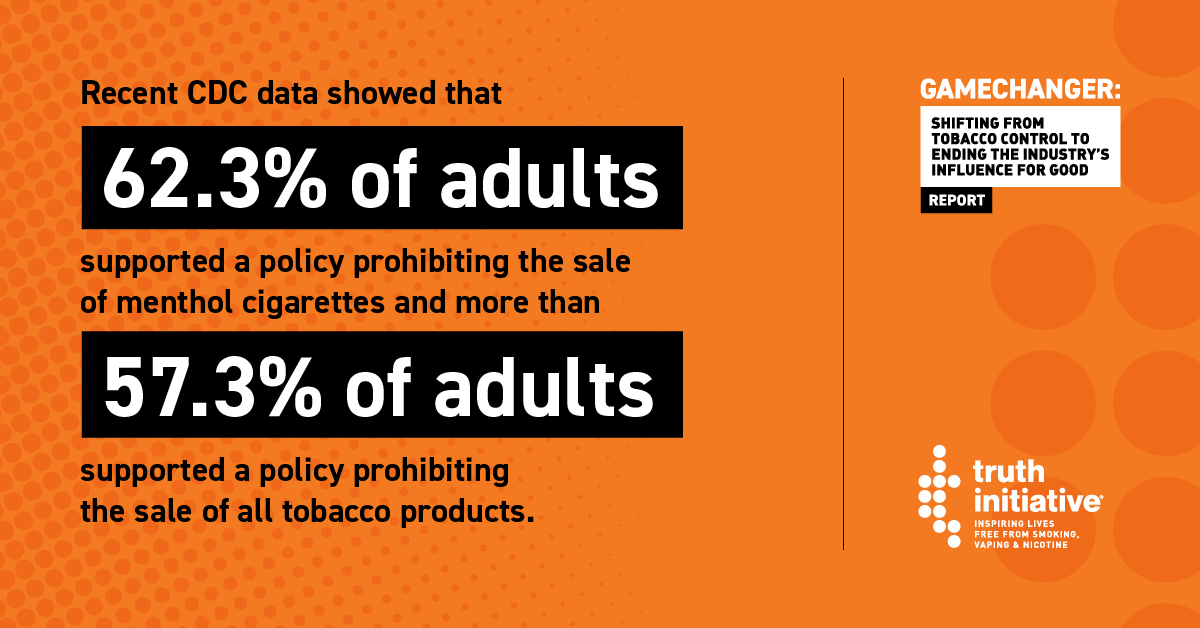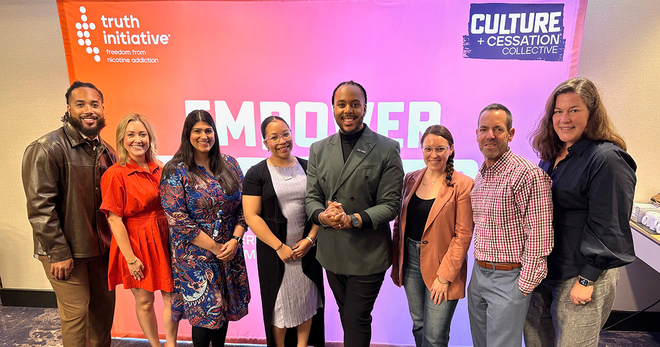What does a tobacco “endgame” mean?
“Endgame” is a strategy to move toward the end of commercial tobacco and nicotine use, with the exception of FDA-approved nicotine replacement therapies. Ending commercial tobacco use would require a huge societal shift, yet support for this vision is already gaining momentum among U.S. public health experts, policymakers, and the public, with recent CDC data showing that more than 57.3% of adults surveyed supported a policy that would eliminate the sale of all tobacco products. Public support is already leading to the adoption of endgame policies at the local and state level, and proposed policies at the federal level.
A recent Truth Initiative report highlights these strategies, and what must come next if we are to make meaningful progress toward a tobacco-free future. It’s important to note that these policy changes are not prohibitionist policies that call for the immediate removal of commercial tobacco product sales. Instead, strategies are aimed at manufacturers, distributors, and retailers without targeting or criminalizing consumer use or purchase.
With a coordinated approach of near, medium, and long-term policy changes, combined with increased public education and quitting programs, it is possible to make commercial tobacco use a thing of the past.

First steps: near-term priorities
A number of factors influence when and how endgame policies can be implemented. Some policies can be put into place more quickly (i.e., in places where tobacco prevention and cessation measures already exist) while others will take more time. A strong foundation must be laid to encourage public acceptance and ensure availability of sufficient and evidence-proven quitting services.
The following near-term priorities expand on policies that already exist in some communities and include recommendations for changes at both the federal and state level – a requirement to mitigate industry efforts to thwart policies at all levels.
Implementing flavored tobacco restrictions:
- The FDA must finalize and implement rules to prohibit the marketing of menthol-flavored cigarettes and cigars and complete its work through the premarket tobacco product application (PMTA) process to keep non-tobacco-flavored nicotine products off the market.
- The FDA should issue product standards to eliminate all characterizing flavors (except tobacco flavor) in all products. This includes concept flavors and ingredients that create a heating or cooling sensory experience to mimic menthol or other flavors.
- At the state and local level, communities can accelerate the elimination of flavored products by passing and implementing more comprehensive restrictions on sales of flavored products.
Restricting points of sale at the state and local level:
- Limit the sales of all tobacco products to adult-only stores.
- Cap the number of tobacco outlets and prohibit tobacco outlets from being close to youth-sensitive areas like schools and parks.
Reducing nicotine levels in combustible tobacco products:
- The FDA should propose a rule to cap the nicotine in combustible tobacco products at non-addictive levels, therefore lowering the number of people who start smoking, help people quit, and reduce tobacco-related mortality.
The FDA estimated that a nicotine cap in cigarettes would result in approximately 5 million additional smokers quitting smoking within one year of implementation and, by the year 2100, more than 33 million people – especially youth and young adults – would be prevented from becoming regular smokers, resulting in more than 8 million fewer tobacco-related deaths through the end of the century.
Improving cessation access:
- Federal, state, and local government agencies, as well as private insurers, should make cessation interventions as accessible as possible, including coverage for multiple quit attempts per year with no copays.
- The FDA should quickly approve existing nicotine replacement therapies for long-term use.
Expanding on foundations: medium-term to long-term priorities
The following policies could take longer to put into place due to political and public readiness and may depend on the development of scientific evidence over time.
Developing new cessation interventions:
- The FDA should create clearer pathways through the Center for Drug Evaluation and Research (CDER) and the Center for Devices and Radiological Health (CDRH) for products and interventions that are proven to help people quit and have been approved as treatments. The pharmaceutical industry and others should continue to develop these tools and the FDA should facilitate an expedited approval pathway to the market.
Capping nicotine levels and delivery in all tobacco and nicotine products:
- The FDA should issue product standards to reduce the level of nicotine in all tobacco and nicotine products. The agency has already indicated that it will do so for cigarettes, but this can and should be extended to all tobacco products, including e-cigarettes.
- State and local governments can implement sales restrictions to limit the level of nicotine in tobacco products sold in their jurisdictions.
Prohibiting sales to younger generations:
- Enact policies that raise the minimum legal age of sale for tobacco products, so that no one born after a specified date can be legally sold tobacco or nicotine.
Restricting commercial sales of cigarettes and all other combustible tobacco products:
- States and localities can prohibit the sales of all tobacco and nicotine products within their jurisdictions.
Despite protestations from the tobacco industry, banning tobacco sales in various jurisdictions is not akin to prohibition from the 1920’s. There is no evidence to suggest that bans would result in catastrophic retail losses, underground sales, or any of the other dire warnings promulgated by pro-tobacco audiences.
Action is needed while public support for tobacco policies gain momentum
With youth smoking prevalence at an all-time low, there is an opportunity to harness this momentum and take strides to achieve a future where all Americans have the right to live free from tobacco and nicotine addiction.
More in tobacco prevention efforts
Want support quitting? Join EX Program
By clicking JOIN, you agree to the Terms, Text Message Terms and Privacy Policy.
Msg&Data rates may apply; msgs are automated.


